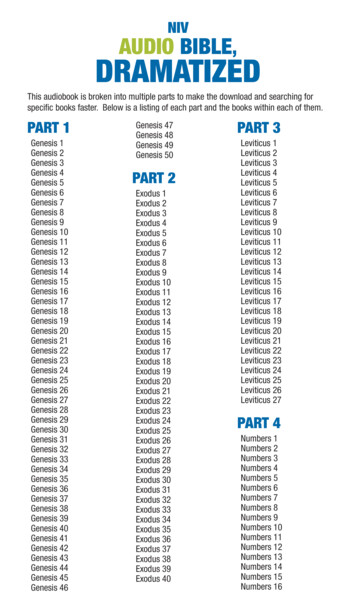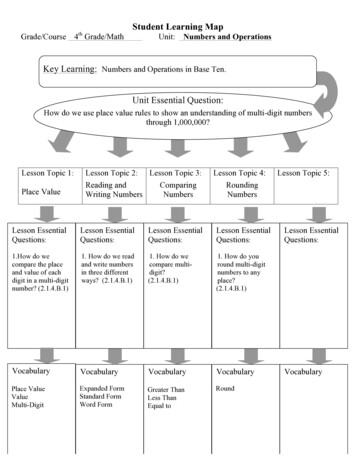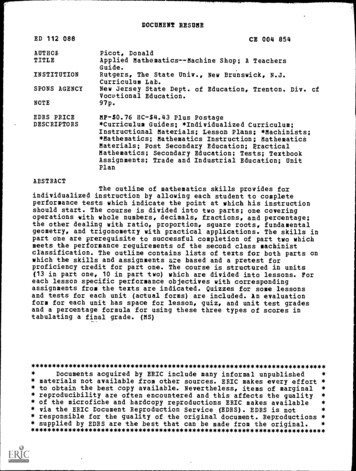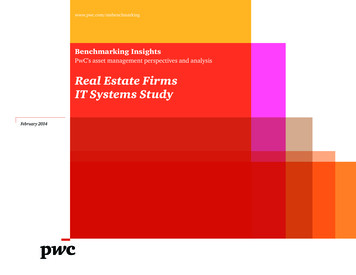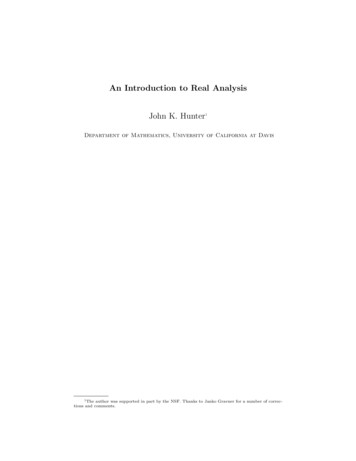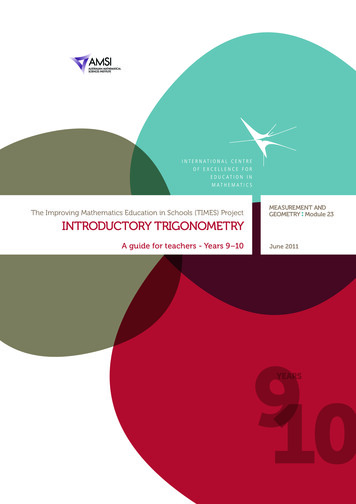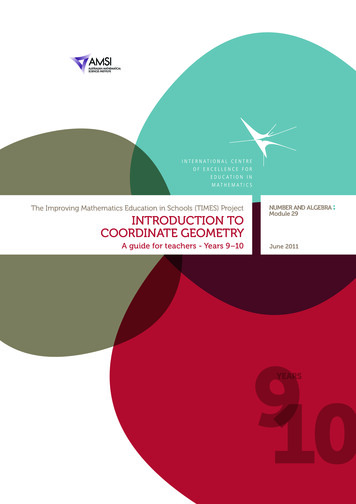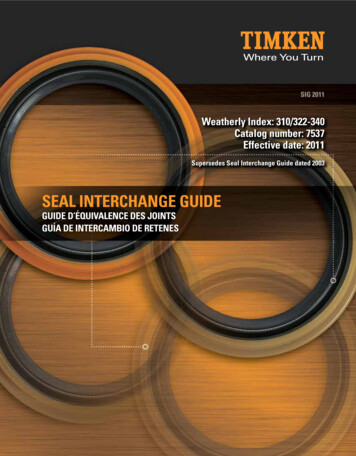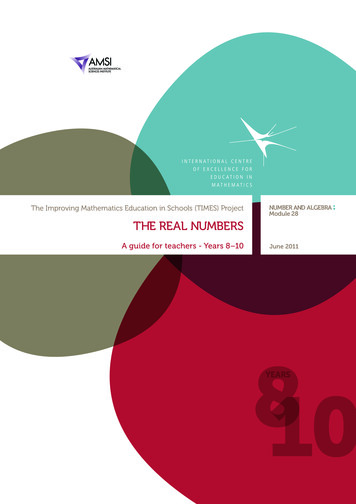
Transcription
The Improving Mathematics Education in Schools (TIMES) ProjectTHE REAL NUMBERSA guide for teachers - Years 8–10NUMBER AND ALGEBRAModule 28 June 2011810YEARS
The Real Numbers(Number and Algebra : Module 28)For teachers of Primary and Secondary Mathematics510Cover design, Layout design and Typesetting by Claire HoThe Improving Mathematics Education in Schools (TIMES)Project 2009‑2011 was funded by the Australian GovernmentDepartment of Education, Employment and WorkplaceRelations.The views expressed here are those of the author and do notnecessarily represent the views of the Australian GovernmentDepartment of Education, Employment and Workplace Relations. The University of Melbourne on behalf of the InternationalCentre of Excellence for Education in Mathematics (ICE‑EM),the education division of the Australian Mathematical SciencesInstitute (AMSI), 2010 (except where otherwise indicated). Thiswork is licensed under the Creative Commons AttributionNonCommercial-NoDerivs 3.0 Unported License. 3.0/
The Improving Mathematics Education in Schools (TIMES) ProjectNUMBER AND ALGEBRAModule 28 THE REAL NUMBERSA guide for teachers - Years 8–10June 2011Peter BrownMichael EvansDavid HuntJanine McIntosh810Bill PenderJacqui RamaggeYEARS
{4}A guide for teachersTHE REALNUMBERSASSUMED KNOWLEDGE Fluency with integer arithmetic. Familiarity with fractions and decimals. Facility with converting fractions to decimals and vice versa. Familiarity with Pythagoras’ Theorem.MOTIVATIONThis module differs from most of the other modules, since it is not designed to summarisein one document the content of material for one given topic or year. Material relatedto the real numbers is scattered throughout the modules. We felt, however, that it wasimportant to have a short module on the real numbers to bring together some of theimportant ideas that arise in school mathematics.From the beginning of their mathematical studies, students are introduced to the wholenumbers. Later, fractions and decimals are introduced, leading to the notion of a rationalnumber, then the integers and negative fractions and decimals are covered. Finally thenotion of real number is gradually introduced after Pythagoras’ theorem has been covered.Throughout this module we will use the term rational numbers for positive and negativefractions including the integers. The rational numbers are numbers of the form mn wherem is an in integer and n a non‑zero integer. An irrational number is a number which is enumbers
The Improving Mathematics Education in Schools (TIMES) ProjectThe integers and rational numbers arise naturally from the ideas of arithmetic. The realnumbers essentially arise from geometry. Finding the length of the diagonal of a squareleads to square roots of numbers that are not squares. When we draw a circle whoseradius is a whole number and ask for its diameter and area, the answer involves theirrational number π.1202192π32345It was as a consequence of Pythagoras’ theorem that the Greeks discovered irrationalnumbers, which shook their understanding of number to its foundations. They also realisedthat several of their geometric proofs were no longer valid. The Greek mathematicianEudoxus considered this problem (see the History section), and mathematicians remainedunsettled by irrational numbers for a very long time. The modern understanding of realnumber only began to be developed during the 19th century.It is not possible to give a rigorous treatment of real numbers at high school. Nonetheless,we can give a reasonable answer to the student who asks What is a real number?’ andwe can also explain why such numbers are important.CONTENTRATIONAL NUMBERSpA rational number is one that can be expressed in the form q where p is an integer,and q is a non-zero whole number. Fractions, terminating and recurring decimals are allexamples of rational numbers.Thus:55 1 , –3 –31 ,282 3 3 , –6.19 –619100 ,20% 15are all examples of rational numbers.In the module, ‘Integers’, we showed, in an appendix, how the integers could beconstructed from the whole numbers using ordered pairs. In the first Appendix tothis module we show how the rational numbers can be constructed in a similar way.36This is needed to cope with the multiple representation of a fraction. For example, 4 8 .{5}
{6}A guide for teachersYou will have seen in the module, Decimals and Percentages. That every fraction can beexpressed as either: a terminating decimal, for example, a recurring decimal, for example,2758 0.625, or 0.285714, and16 0.16 where the dots indicaterepetition.pA fraction, q , in reduced form where p and q are whole numbers with no commonfactors, will have a terminating decimal representation if and only if q has no prime factorsexcept 2 and 5.All fractions can be converted to a decimal by using long division. This involves dividingthe denominator into the numerator. A zero remainder at some stage in the divisionwill result in a terminating decimal. If the remainder is never zero, then division by adenominator q will result in a repeating pattern of remainders after at most (q – 1) steps(see the module, Decimals and Percentages).EXERCISE 1Use long division to find the decimal expansion of131 .EXERCISE 2a Find a rational number midway between the rational numbersabandcd.b Explain how this can be used to show that there are infinitely many rational numbersacbetween b and d .Decimals to FractionsThe technique for converting decimals to fractions depends on whether the decimalis terminating, recurring or eventually recurring. A terminating decimal can be easilyconverted back to a fraction by using a denominator which is a power of 10.14For example, 3.14 3 100 3 750 15750 .The following example demonstrates the method for converting recurringdecimals to fractions.
The Improving Mathematics Education in Schools (TIMES) ProjectEXAMPLEConvert 0.123 to a fraction.SOLUTIONLet x 0.123 0.123123123 . .We multiply by 103 as the repeating block has length 3.Then 1000x 123.123123 . . 123 x123Hence 999x 123 and so x 999 Thus we obtain 0.123 41333 .41333 .An eventually recurring decimal can easily be handled by firstly multiplying it by asufficiently high power of 10 to make its decimal part purely recurring.EXAMPLEConvert 0.69123 to a fraction.SOLUTIONLet x 0.69123 0.69123123123 .Then 100 x 69.123123 . . 69.123.Multiply by 1000100000x 69123.123123 . 69123.1236905411509Subtracting, we obtain 99900x 69123 – 69 69054 and so x 99900 16650.11509Thus we obtain 0.69123 16650PARADISE LOSTWe first prove the following result about fractions:‘If a fractionabis not a whole number, then its squarea2b2is not a whole number either.’ProofaSuppose that b is in reduced form, so that a and b have no common factors except 1.Then a2 and b2 also have no common factors, because if any prime p were a commonfactor of a2 and b2, it would also be a common factor of a and b.a2Hence b2 is not a whole number.{7}
{8}A guide for teachersSince 2 is not a whole number, but its square is the whole number 2, it follows from theabove result that 2 is not a rational.This caused great upset to the Greek mathematicians, since it introduced a newsort of number which they called an irrational number. An older word for this isincommensurable, which meant that it could not be measured as a ratio of two wholenumbers. This discovery caused a dramatic rethink into the nature of number. The validityof many of their geometric proofs, which assumed that all lengths could be measured asratios of whole numbers, was also called into question.The proof given above can easily be adapted to prove that if a whole number x is not annnth power, then x is not a rational number. Thus we have infinitely many examples ofirrational numbers, such as:1235 , 7 , 31Such numbers are called surds and will be discussed in detail in the module, Surds.In addition, numbers such as π, log10 3, log2 6, sin 22 , and so on, are also irrational,although it is harder to prove this fact for the first and last of these examples. There is nogeneral method for telling when a number is irrational, and indeed there are numberssuch as π e that arise in mathematics whose status is currently unknown.EXAMPLEProve that log2 5 is irrational.SOLUTIONAs with the proof that 2 is irrational, we begin by supposing the contrary.Suppose that log2 5 pq,where p and q are whole numbers.We can rewrite this statement without logarithms asp5 2q.Raising both sides to the power gives,5q 2p.Now this ‘equation’ is impossible, since the left hand side is odd, while the right hand sideis even. Thus, log2 5 is irrational.The Fundamental Theorem of Arithmetic (The module, Prime and Prime Factorisation’ )can be used to generalize this result.
The Improving Mathematics Education in Schools (TIMES) ProjectTHE REAL NUMBERSThink about graphing the rational numbers between 0 and 2 on the number line. First wegraph 21 , 1 21 , then the thirds, then the quarters, then the fifths, . As we keep going, thegaps between the dots get smaller and smaller, and as we graph more and more rationalnumbers, the largest gap between successive dots tends to zero.012If we imagine the situation when all the infinitely many rational numbers have beengraphed, there appears to be no gaps at all, and the rational numbers are spread out likepieces of dust along the number line. Surely every point on the number line has beenaccounted for by some rational number?Not true! There are infinitely many numbers that we have not graphed, all rationalmultiples of 2, including:2,122,132,142,152, .πOf course, there are many more missing numbers, like 3 and log2 3 and 2 . We needa new definition of ‘numbers’ that will cover all these irrational objects, which are notrational numbers, but which we nevertheless want to think of as numbers. The solution isvery simple — we make an appeal to geometry and define numbers using the geometricalidea of points on a line:DefinitionThe real numbers are all of the points on the number line.The set of real numbers consists of both the rational numbers and the irrational numbers.Constructing real numbersWe have seen in the module ‘Constructions’ thatevery rational number can be plotted on the3number line. For example, to plot 5 we firstdivide the interval from 0 to 1 into 5 equalsubinterval (this requires the construction of0parallels, but that detail is not shown in the diagram).Then we count along 3 subintervals and place a dot.Thus rational numbers are indeed special cases of real numbers.351{9}
{10}A guide for teachersWe also saw how to place the square root of anywhole number on the number line using Pythagoras’theorem. For example, to plot 2 we first construct asquare on the interval from 0 to 1 (the constructionsof the right angles are not shown on the diagram).Then we draw the diagonal from 0, which haslength 2, and use compasses to place this lengthon the number line.0122The real numbers and the rational numbersWe have seen that as we place halves, thirds, quarters, fifths, on the number line, themaximum gap between successive fractions tends to zero. Thus if is any real numberthen rational numbers will be placed increasingly close to . Thus we can use rationalnumbers to approximate a real number correct to any required order of accuracy.221221For example, the diagrams above show a circle of area π enclosed in a square of area4, and enclosing a square of area 2, which proves that 2 π 4. Archimedes improvedgreatly on this result by using regular polygons with 96 sides, and was able to prove that1103 7 π 3 71 .Modern computer calculations, and the extremely clever algorithms they are based on,give approximations to π up to a trillion decimal places.But beware! These observations might lead one to believe naively that the rational andirrational numbers somehow alternate on the number line. Nothing could be furtherfrom the truth. Even though there are infinitely many rational numbers and infinitely manyirrational numbers between 0 and 1, there are vastly more real numbers in that intervalthan rational numbers.This spectacular, but rather vague, claim can be made into a theorem as precise as anyother mathematics, and proven rigorously — see the Appendix 2 for the details, which arean excellent challenge for interested and able students. Intuitively, one should see the realnumber line as a continuum, with the points joined up to make a line, whereas the rationalnumbers are like disconnected specks of dust scattered along it.
The Improving Mathematics Education in Schools (TIMES) ProjectThe real numbers and decimalsWe have seen that every rational number can be written as a terminating or recurringdecimal. Conversely, every terminating or recurring decimal can be written as a fraction,and thus as a rational number. Now suppose that we have a decimal that is neitherterminating nor recurring, such as 1.01001000100001 . where the number of zeroesincreases by 1 each time. This decimal represents a definite point on the number line,and so is a real number, but it is not a rational number, because it neither terminates norrecurs. Indeed, any infinite decimal that is neither terminating nor recurring representsan irrational real number, and two different such infinite decimals represent different realnumbers.Now suppose that is an irrational real number between 0 and 1. As we add tenths,hundredths, thousandths, .to the number line between 0 and 1, the gap between adjacentdots decreases to zero.01By placing successively between the tenths, between the hundredths, between thethousandths, we can produce an infinite decimal expansion that represents . Theconclusion of all this is the following theorem.‘Every real number can be represented by one, and only one, infinite decimal (excludingrecurring nines). If the expansion terminates or recurs, the number is rational, otherwisethe number is irrational.’Approximating real numbers by decimalsThere are many ways of approximating real number by decimals. The two simplest aredescribed below.Sequence of truncationsNow consider the infinite decimal expansion of a real number If we truncate thisexpansion at 1 place, 2 places, 3 places, , the result is a sequence of rational numbers(terminating decimals) converging to . For example, the decimal expansion of π is knownto nearly 3 trillion places, and beginsπ 3.141592653589793238462643383279502884197169399375 so the sequence of truncations begins3.1, 3.14, 3.141, 3.1415, 3.14159, 3.141592, 3.1415926, 3.14159265, {11}
{12}A guide for teachersSequence of approximationsTo approximate the real number to a given number of decimal places, we truncate it oneplace more and then round in the usual way. Thus the sequence of approximations to π are3.1, 3.14, 3.142, 3.1416, 3.14159, 3.141593, 3.1415927, 3.14159265, Of course this procedure can be applied just as easily to a recurring decimal, or to anoverlong terminating decimal. This method of approximating real numbers by terminatingdecimals of whatever length is required is one reason why decimal expansions are souseful in science and everywhere that mathematics is applied.Arithmetic with real numbers — using approximationsHaving defined real numbers as points on the number line, how are we to define addition,subtraction, multiplication and division of real numbers? The most obvious approachis to work with their decimal expansions, and add, subtract, multiply and divide suitabletruncations of these expansions. For example, suppose we want to add, subtract, multiplyand divide π and 2 correct to two decimal places.We obtain correct to two decimal placesπ 2 4.56, π – 2 1.73, π 2 4.44, π 2 2.22,For people such as calculator and computer programmers who are concerned with theaccuracy of such calculations, there are serious problems here about the number ofdecimal places necessary in the calculations and the sizes of possible errors, but thesethings need not concern us here.It is, however, worth commenting on the infinitely recurring 9s that result from attemptingnon- truncated calculations such as0. 3 3 3 .0. 3 3 3 .0. 6 6 6 . 30. 9 9 9 .0. 9 9 9 .We know that both answers are 1, because 13 23 1 and13 3 1In the module, Decimals and Percentages we defined 0.9 1. To justify this, we remarkedthat if 0.9represents a number x, then 1 – x is a non-negative number less than everypositive number, so 1 – x 0. Similarly, any decimal expansion with an infinite string of 9scan always be replaced by a terminating decimal.
The Improving Mathematics Education in Schools (TIMES) ProjectArithmetic with real numbers — using geometrySince real numbers have been defined geometrically, we should be able to describethe operations of arithmetic with real numbers using geometry alone. Addition andsubtraction are straightforward. We can construct the sum a b of two real numbersa and b in the usual way. We draw a straight line and on it mark off with a compass thedistances OA a and AB b. Then OB a b. Similarly for a – b we mark of OA aand AB b but this time with AB in the opposite direction to OA. Then OB a – b.The opposite of a real number can be constructed as its reflection in the origin (usingcompasses). Multiplication and division require similarity. We have taken the similarity testsas axioms of our geometry, and we now can construct multiplication and division of realnumbers on the number line in terms of the ratios and products of lengths introducedin the theory of similarity. The following exercise shows how to construct the product1ab, the quotient a b and the reciprocal a on a number line, where a and b are positivereal numbers. Reflection in the origin then extends these constructions to negative realnumbers.EXERCISE 3Let a and b be positive real numbers on the number line as shown, where the pointsO, I, A and B represent the numbers 0, 1, a and b respectively.Construct any other line m through O. Then use compasses to make m into a numberline, by constructing points I and B on m such thatOI OI 1 and OB OB b.Join the interval I A, and construct lines parallel to I A:B through B , meeting at P,Q through B, meeting m at Q,R through I, meeting m at R.lOUsing similar triangles, show thatOP ab, OQ baand OR m1AaBbP1aThus P represents the product a b, Q represents the quotient b a, and R represents the1reciprocal a .In an earlier exercise you proved that between any two rational numbers there is a rationalnumber. The following exercise shows that between any two rational numbers there is anirrational number.{13}
{14}A guide for teachersEXERCISE 4Suppose that a and b are any two rational numbers, with a b.Let x a 12 (b– a).a Prove that x is irrational.b Show that a x b.Thus there is an irrational number lying between the two rational numbers a and b.Show that there are infinitely many irrational numbers lying between two rationalnumbers.It is also possible to show that between any two irrationals there is a rational number.This is harder and is left to the Links Forward section.The Real Numbers and AlgebraNumbers other than rational number frequently occur in problems involvingmeasurement, areas and volumes, where the number π often makes an appearance.Quadratic surds also arise quite naturally when we find heights and sides of triangles.A quadratic surd involves the square root of a non-square whole number. Irrationalnumbers also arise in trigonometry since the sine, cosine and tangent ratios of mostangles are irrational. We usually approximate these numbers using a calculator. Certainspecial angles have quadratic surds as their sine, cosine or tangent ratios.For example, cos 30 32,sin 45 12.Irrational numbers also arise when we solve equations of degree greater than one. Thus,3the real solution of x3 5 is x 5 .Quadratic surds often arise when we solve quadratic equations using either the method ofcompleting the square or the quadratic formula.EXAMPLESolve x2 – 3x – 7 0.SOLUTIONThe quadratic formula, x x 3 9 282 –b b2 – 4ac,2awith a 1, b –3, c –7 gives3 37 3 – 37, 2 .2These may now be approximated, or left in exact form.
The Improving Mathematics Education in Schools (TIMES) ProjectWhen performing calculations, it is best to leave real numbers in exact form, at least untilthe end of a problem. We can then, if required, find approximate values. Converting realnumbers to decimal approximations can lead to cumulative rounding errors.LINKS FORWARDSEQUENCESWe can approximate all irrational numbers by rational numbers. This is often done bymeans of sequences.Define the sequence a1, a2, by a1 1 and for n 1 an 1 12an 2an.Substituting in successive values, we obtaina1 1 , a2 1.5, a3 1.416666 , a4 1.4142156 , and so on.These numbers appear to be getting closer to the decimal 1.41421 which is thebeginning of the decimal expansion for 2. If we assume that this sequence convergesto some real number that is, we assume that the terms of the sequence approach asgrows without bound. As n gets bigger and an 1 gets closer to an a good idea of what should be can be found by replacing an and an 1 in the equation above by and we have 12 2,which simplifies to, 2 2. So 2 since is positive. Thus we have a sequence ofrational numbers which converge to the real number 2.Approximations to many real numbers can be obtained in this way.EXERCISE 5Define the sequence a1, a2, by a1 1 and for n 1, an 1 12an 3an.Find the first five terms of this sequence and, assuming that the sequence convergesshow that it converges to 3.Rationals between irrationalsWe have seen that between any two rational numbers there is a rational number between any two rational numbers there is an irrational number.It is also possible to show that{15}
{16}A guide for teachers between any two irrational numbers there is a rational number between any two irrational numbers there is an irrational number.Here is a proof of the third dot point.ProofSuppose we take two irrational numbers, which we may as well assume are positive,where .We imagine that these two numbers are very close to each other, (although the proofworks the same if they are not), so that the number – is small.n( – ) nnnNow no matter how small is, we can always multiply it by a whole number n to makethe product greater than 2.(For example, if 0.00003145., then we take n 60 000 say, then n 2.07 2.)Now look at the numbers na, nb. The distance between these numbers isnb – na n( – ) n 2.Since there is a gap of at least 2 between these numbers, then there is at least onewhole number m, between them. That is,na m n .Dividing by n we have,a mn .Since m and n are whole numbers, we have constructed a rational number betweenthe two given irrational numbers.EXERCISE 6Adapt the above proof to prove ‘There is an irrational number between any two irrationalnumbers’EXERCISE 7Use the method in the proof (and your calculator) to find a rational number between 10and π.
The Improving Mathematics Education in Schools (TIMES) ProjectCONTINUED FRACTIONSA continued fraction is an expression with either a finite or infinite number of stepssuch as 2 3 115 1.7If we truncate the continued fraction somewhere, it can be simplified to produce arational number. For example,2 3 1 2 15 1713 11367 2 3 736 2 36115 266.115The continued fraction given here is usually represented using the notation [2; 3, 5, 7].It is easy to see that a rational number has a finite continued fraction. Therefore continuedfractions that continue indefinitely represent irrational numbers. Continued fractionsthat repeat, such as [1; 2, 2, 2, 2, .], which we write as [1; 2], represent quadratic surds,that is, surds of the form a b, with a, b rational and conversely, every quadratic surd isrepresented by an (eventually) repeating continued fraction.EXERCISE 8Expand as rational number the first five terms of the continued fraction for [1; 2] (the firstterm is just 1), and find their squares as decimals, correct to six decimal places.Thus the continued fraction [1; 2, 2, 2, 2, .] appears to represent the number 2.To show this, we write x [1; 2, 2, 2, 2, .] 1 Thus, from x 1 11 x12 12 . 1 1.2 (x – 1)we obtain x x2 1 x 1 which gives x2 2.Since x 0, x 2.We can use the calculator to ‘discover’ the continued fractions for other irrationalnumbers. For example, to find the continued fraction for 3, we enter this into thecalculator, copy down the whole number part, 1, subtract it and push the reciprocal key( x1 button) giving 1.3660 . Again copy the whole number part, 1, subtract it and pushthe reciprocal button giving 2.73 . Copy 2 and repeat, giving 1.3660 (again). Hence(assuming the pattern continues), we have the continued fraction 3 [1; 1, 2, 1, 2, .].EXERCISE 9Using the method outlined above for 2 show that the repeating continued fraction [1; 1,2, 1, 2, .] does indeed equal to 3.Beyond quadratic surds, we do not know a lot about continued fractions. They are rathermysterious and there are many unsolved problems related to them. The continuedfractions for the numbers π and e appear to have very different forms –π [3; 7, 15, 1, 292, 1, 1, 1, 2, 1, 3, 1, 14, 2, 1, 1, 2, 2, 2, 2, 1, 84, .]{17}
{18}A guide for teacherswith no apparent pattern here, whilee [2; 1, 2, 1, 1, 4, 1, 1, 6, 1, 1, 8.]where the obvious pattern continues forever.The continued fraction for the golden ratio is [1; 1, 1, 1, 1, 1 ].1 52and its continued fractionContinued fractions give good rational approximations to irrational numbers.EXERCISE 101The first two terms of the continued fraction for π give the usual rational approximation 3 7Use the first 3 terms and then the first four terms to find better rational approximations to π.COMPLEX NUMBERSWe saw that real numbers arise algebraically when we try to solve equations such as x3 5. The real numbers alone are, however, not sufficient to solve all polynomial equations.Since the square of any real number is positive, it is not possible to solve x2 1 0 , usingreal numbers. To solve this equation, we need to introduce a new kind of number, whichis called i, and has the property that i 2 –1. We can then construct the set of all complexnumbers. This consists of the set of all numbers of the form a ib where a and b are realnumbers. It turns out that all polynomial equations with real or complex coefficients canbe solved using the complex numbers.HISTORYThe ancient Greeks were probably the first to have discovered the existence of irrationalnumbers. The led them to realize that many of their geometric proofs were no longervalid. Here is an example of this.Consider the simple problem of proving that two triangles with the same height have theirareas in the same ratio as their bases.ABCDEHence, referring to the diagram, we need to prove that ABC ADE BC DE .
The Improving Mathematics Education in Schools (TIMES) ProjectHere is the Pythagorean proof of the given theorem. It assumes that all lengthsare rational.Suppose u is a unit of length going n times into BC and m times into DE. Mark off thepoints of division on BC and DE.ABCDEThen triangles BCA and DEA are divided into n and m smaller triangles respectively, allhaving the same area. Hence ABC ADE mn BC . DE The objection to this proof is that BC and DE could bethe construction breaks down. BC DE couldbe irrational. In this caseEudoxus developed a new definition and new approaches for comparing rational andirrational magnitudes.THE NUMBERS π AND eThe Arabic mathematician Muhammad ibn Musa al-Khwarizmi (9th century), who wrotethe first major treatise on algebra, believed that π was irrational but had no proof.In 1768, over 800 years later, Johann Lambert gave a proof that π is irrational. His proofis clever and not too difficult, but it uses ideas from calculus. A modified proof, whichis accessible to very good students in their final year of high school level mathematics,is outlined in Question 8 of the NSW Higher School Certificate Extension 2 Paper from2003, at the following web page: http://www.boardofstudies.nsw.edu.au/hsc exams/hsc2003exams/pdf doc/mathematics ext2 03.pdfThe number e, which arises in Calculus and elsewhere, is also irrational. Its approximatevalue is 2.718281828 correct to 9 decimal places. (Despite the apparent pattern, this is nota repeating decimal.) The proof that e is irrational is generally attributed to Euler. Onceagain, a proof which is accessible to very good students in their final year of high school,is outlined in Question 8 of the NSW Higher School Certificate Extension 2 Paper from2001, at the following web page: http://www.boardofstudies.nsw.edu.au/hsc exams/hsc2001exams/pdf doc/mathemat ext2 01.pdfThe late eighteenth and early nineteenth century saw the beginnings of what we callanalysis which examines the theoretical underpinnings of calculus. The mathematicians{19}
{20}A guide for teachersCauchy, Weierstrass and Dedekind were the founders of analysis. In 1872 RichardDedekind published a paper in which he showed how to construct the real numbersystem using a procedure known nowadays as a Dedekind cut. This is a way ofconstructing a real number by dividing the rational line into two sets. For example, thenumber 2 can be identified with the sets (cut) x rational and x2 2 or x 0 and the set xrational and x2 2 and x 0. Using these ‘cuts’ Dedekind was able prove all of the basicproperties of the real numbers. The other standard method of defining real numbers is viasequences, called Cauchy sequences.Finally we mention the mysterious number , called Euler’s constant, which is defined bythe following limit. It first appeared i
notion of real number is gradually introduced after Pythagoras’ theorem has been covered. Throughout this module we will use the term rational numbers for positive and negative fractions including the integers. The rational numbers are numbers of the form . n.
